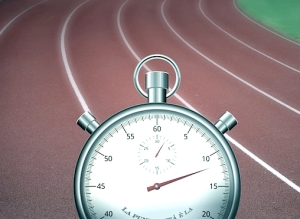Just how important is that post workout snack? Is it necessary to eat it right after my workout, even before I shower?
Evidence shows us that during and following a workout, our bodies crank up the number of amino acid transporters (little taxis for small pieces of protein) on the surface of muscle cells, secondly, insulin sensitivity is increased, so muscles take in sugar and fat from the blood stream more readily, and finally, an increase in circulating anabolic (muscle building) hormones occurs. Thus we have an environment favoring protein accretion and presumably muscle growth. Ingesting dietary protein at this time is optimal as our bodies will preferably utilize recently ingested nutrients before taking from the free floating amino acid pool, or if that is exhausted, from storage. Taking from “storage” of course is generally not preferable because it requires taking things apart to get at the necessary amino acids, or breaking down muscle, as that is one place amino acids are in abundance. There is no consensus on exactly how much protein (the supplier of amino acids in our diet) is optimal following a resistance training workout but literature suggests .25g/kg bodyweight might work the best.
Of course protein is NOT nearly as important as refueling muscle glycogen (stored sugar, used by muscles), which, again, the literature varies but generally 1-2g/kg bodyweight as soon as possible following the workout (any type of workout, not just resistance training). Additionally, ingesting carbohydrates with protein appears to aid with amino acid absorption. Ideal carbohydrate to protein ratio in a post workout snack is 3-4:1. Done deal right? Everyone should have a post workout snack within an hour of the workout to optimize recovery, and muscle growth. Hold on, while all this is well supported in the scientific literature and appears to be true, there is another side to it.
Evidence also shows us that this “window” of opportunity, the hour following the workout, doesn’t just disappear after an hour. The window gradually closes, remaining open to some degree up to six hours following the workout, in some cases, scientists find it remains open, though not as “wide” up to 24 hours. Furthermore, athletes who fail to eat during the 1 hour “window” of opportunity but still consume enough calories to support their needs over a 24 hour period appear to make similar gains in muscle mass and performance to those athletes who consume protein and carbohydrates in the recommended amount during the “window” following their workout
Of course more work needs to be done to determine exactly what we ought to be doing but likely what we’ll find is some athletes, elite athletes perhaps, who pay close attention to nutrient timing will indeed gain that extra fraction of a benefit that is important at their level. The rest of us are probably not going to suffer performance decrements so long as we are getting the right foods in the right amounts in the long run. There is more to this picture, as the “speed” of absorption of the protein matters, the “quality” matters as well. Ideally high quality (contains all amino acids in appropriate amounts, generally animal products, meat, dairy, eggs, fish, poultry), though adequate amounts can be taken from the right combinations of plant based foods as well, however, the speed of absorption may not be optimal. I will talk more on this in a future post. For now, the main messages are as follows:
For elite athletes, who are training more than once per day, have a snack immediately following your training session consisting of carbohydrates at 1g/kg bodyweight, and an amount of high quality fast digesting protein (whey is a good example of this) equal to .25g/kg bodyweight, then repeat in another hour. This should be adequate to replenish muscle glycogen, and presumably stave off protein degradation, which will be necessary for performing the second training session.
For athletes who are trying to lose weight, or do not train multiple times per day, nutrient timing is not as important. Simply make sure that you eat a regularly scheduled meal, such as lunch or dinner within a couple hours of the workout. A normal meal, such as a turkey sub, salad, and juice will cover your nutritional needs from the workout just fine. Your goal is to make sure that you are getting the calories you need over the whole day.
If you are not trying to lose weight, and are training hard, in fact, if you are trying to gain muscle mass, its probably a good idea to have a post workout snack, BUT adjust the rest of your meals accordingly, for gaining muscle mass, you only need an additional 300 kcal per day, anymore than that and the mass gained will not be muscle.
Hope this helps, thanks for reading!





